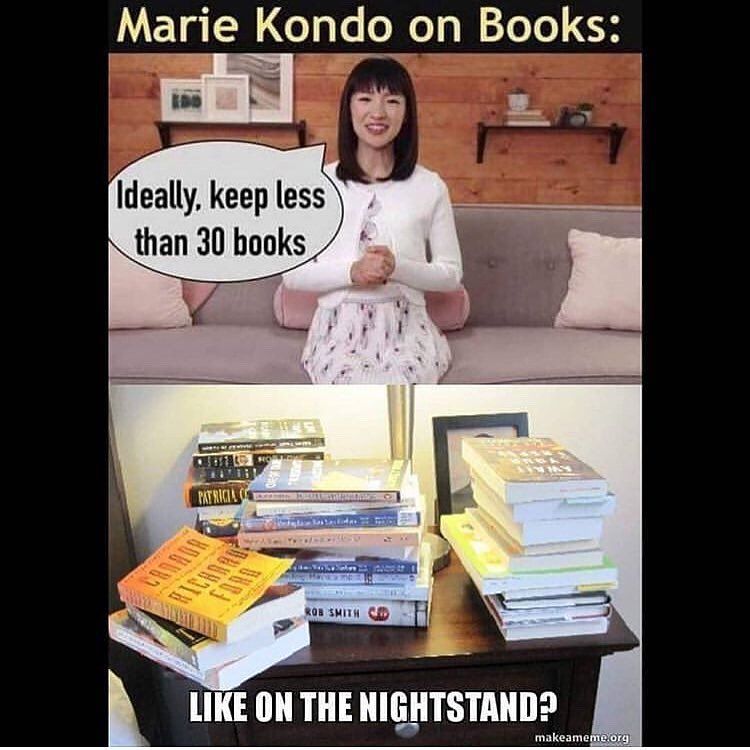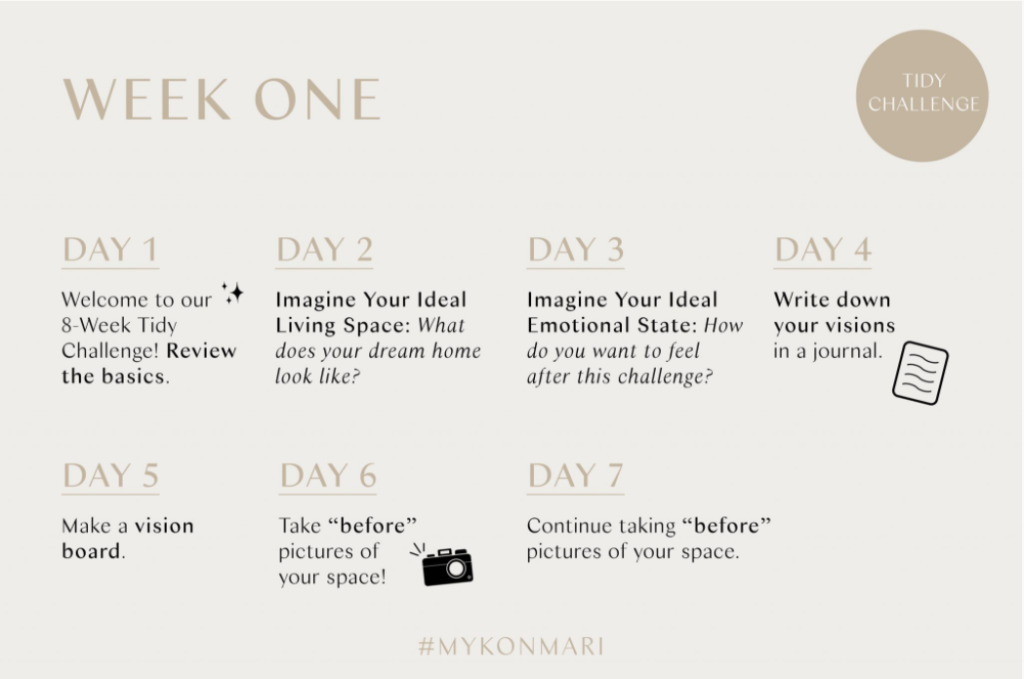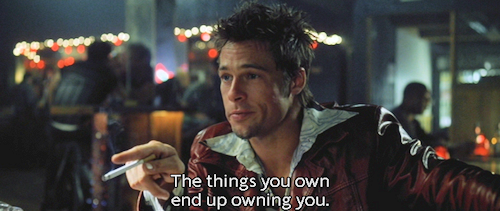Week 1 – Planning
About two years ago, I started to read Marie Kondo’s book The Life-Changing Magic of Tidying Up [1] in an attempt to simplify my life, reduce my clutter, and avoid winding up on an episode of “Hoarders.” Her method is extreme and comprehensive, involving a serious time commitment and some difficult questions about whether or not each item in your home has served its purpose and continues to have a place in your life. I was unable to finish her book because every time I picked it up, I gave myself a panic attack thinking about the sheer scale of work that needed to be done in my house.
Traditional Cleaning
My method of cleaning has always been exactly what she says not to do: I go through a single room and figure out what needs to go in the garbage/recycling, giveaway pile, or get stored in its proper place. As I deal with items that don’t have a proper place (which is most of them), they usually wind up in a pile in another room, so as one room increases in order, the next room increases in disorder. It’s basic thermodynamics: entropy never decreases over time. Or, as I like to joke, my living space follows the Law of Conservation of Mess: it cannot be destroyed; it just changes location.
This situation is not helped by my attention-deficit tendencies (I’m very easily distracted and drawn down a nostalgic rabbit hole whenever I unearth something interesting – and everything is interesting), by my debilitating perfectionism (which I understand correlates very strongly with hoarding tendencies),[2] or by the fact that everything I own has some level of sentimental value (my dad and husband have both respectively joked about my sentimental rocks and sentimental store receipts).

Image credit: [3]
However, because I am starting to feel swallowed up by my things, and because I desire to live more simply, I decided to give the KonMari Method another shot, but to do it in a way that did not give me a daily panic attack, and in a way that recognizes the fact that I have a job and other responsibilities – I can’t simply take time off to do everything as she has described in her book, or as you can see on her show. (Yes, other people have done it, and I commend them, but I am not one of those people.)
Tidying with Marie
My approach will follow Marie’s (I’m on a first name basis with her) “8-Week Tidy Challenge.”[4] I will spend one hour each day working on one specific task, and I will accept the fact that that isn’t enough time to get to everything. This challenge will not only force me to tidy my home but also to embrace the concept of “good enough,” which is challenging enough on its own. After 56 hours of tidying, I do not expect to be anywhere near done, but I do expect to have made progress in the right direction… and maybe that’s enough for now.
Marie got some bad press a few years ago when a quote of hers was taken out of context and spread via meme, inciting wrath among book lovers who thought she required discarding all but 30 books. That is not what her method entails. She has a specific process, but the parameters are defined by you, the individual doing the work. Marie doesn’t tell you what to keep or throw away; she tells you to determine – for yourself – what has meaning, what has a purpose, what brings you joy, and what you want to carry with you into the future. But before you answer those questions, she wants you to envision that future.
When I read her book, she described taking some time before sorting through anything to journal and think about what you wanted to get out of the process. At the time, I imagined this would take about half an hour. In reality, she devotes the entire first week of her eight-week program to envisioning success.

Image Credit: [5]
Start with a Plan
At first I thought missing out on an entire week of tidying just to envision the possibilities was a little excessive. I love to write (and spend hours each week writing this blog), but honestly, how much could I possibly have to say about my “ideal living space”? Well, it turns out that I was able to fill an hour or more each night answering some of her prompts, collecting photos, and seeing this process as a means to an end that I envisioned.
And it makes perfect sense: if she had defined success for me based on her priorities, I wouldn’t have much motivation to get started, let alone persevere through eight weeks of her regimen. I wouldn’t have any buy-in on an arbitrary goal (like 30 books?!). But by defining a successful end point for myself, I can keep my own priorities in mind as I go and keep myself motivated by envisioning an ultimate goal that is meaningful to me.
In describing your ideal living situation, Marie wants you to go beyond the basics like “I want to live in a clean house.” She wants you to examine why you want a clean house: what that signifies to you, what it enables you to do, what mental and physical benefits you might have, etc. Again, the focus is not on what you feel you “should” be doing – because (speaking from experience) saying “I want a clean house because I should be a responsible adult who keeps her house clean” only results in me having a messy house AND feeling bad about it.
A much stronger motivation than self-shaming with “should” is envisioning a goal and continually working toward it. When I ran my first marathon, I didn’t go out and train because “I should have been exercising like a responsible adult” – I went out to train because I wanted to complete a marathon. And it’s working toward that positive outcome, not avoiding self-shaming, that is going to keep me focused over the next seven weeks.

On the left is the living room picture on my vision board. On the right is how my living room looked on Day 6 of the challenge.
My Vision
During Week 1 I imagined details about my ideal living space: if there was a theme, the colors and textures of the furniture, the smells, and the light. I wrote about my motivations to start this project in the first place, what I hope will change in my emotional state and how I interact with my space, and what I hope to gain from the process. Ultimately I was left with these thoughts:
“Why do I aspire to the lifestyle I’ve described over the last few days? It’s an incredibly selfish reason: I want less stress in my life, less tension in my relationship, more time with my husband, more time with our friends, less worry about sorting through things, deciding what to do with things, putting off decisions about things…
It does feel exhausting living around all of this stuff. I’m hoping that afterward it will feel like I’ve just taken a very large shit: relieved, unburdened, lighter, like I can breathe again, no longer uncomfortable, happy to be rid of what I don’t need.
I want to be able to have fun with my space and make it my own, not just exist among stacks of boxes that contain who knows what. I want to feel held by the space, I want to feel like it is a sanctuary for me. A place to come home and recharge after a hard day at work. A place to gather with friends (post-pandemic) and not be exhausted from cleaning for two days straight. (Wouldn’t it be nice to spend that time before a party cooking and mixing drinks, rather than shoving detritus upstairs and shutting doors?)
Oh, I want to live in an organized world where everything actually has a place, and things can be put away where they’re supposed to be, not just wherever there’s a horizontal surface to store them. I want to have organization in the bathroom cabinet, and my spice rack, and the laundry area. How nice would that be? I’d feel like I have some semblance of control over my life.
I think the biggest thing here is the fact that I am taking an active role in doing something that is good for me but completely against my nature. I am actually in control here – I’m not doing this because someone said I should; I’m doing it because I want to change my way of life. I’m the one deciding what stays and what goes, and the determining factor is what continues to make me happy. There’s a lot of power in that.”

Image credit: [6]
Next week we’ll dive into the mess with clothes.
Have you tried Marie’s method? How did it go? I’d love to hear your story below.
Thanks for reading!
[1] https://www.goodreads.com/book/show/22318578-the-life-changing-magic-of-tidying-up
[2] https://www.livescience.com/22140-hoarders-brain-why-they-cant-ditch-stuff.html
[3] https://www.pinterest.com/pin/46161964917059004/
[4] https://konmari.com/category/tidy-challenge/
[5] https://konmari.com/konmari-marie-kondo-tidy-challenge-week-one/
[6] https://medium.com/talko-team-talk-share-do/tyler-durden-would-be-a-great-product-manager-ce4434c836a9
2 Comments
Galen · February 14, 2021 at 10:59 am
I didn’t realize her process had such a lengthy planning stage, but I think it makes sense to help you wrap your mind and heart around what you’re about to do and, as you said, keep it from being a keeping-up-with-the-Joneses “should” guilt-trip. I also greatly admire what you shared from your journal about the many ways this will free you mentally, emotionally, and physically. And the analogy of taking a giant shit is perfect.
Alison · February 14, 2021 at 2:14 pm
Thank you Galen, I’m glad you appreciated the analogy! Although I was really hesitant to talk about (or share pictures of) my hoarding tendencies, I think talking about them in a public way will help to reduce (not increase) the shame I feel.